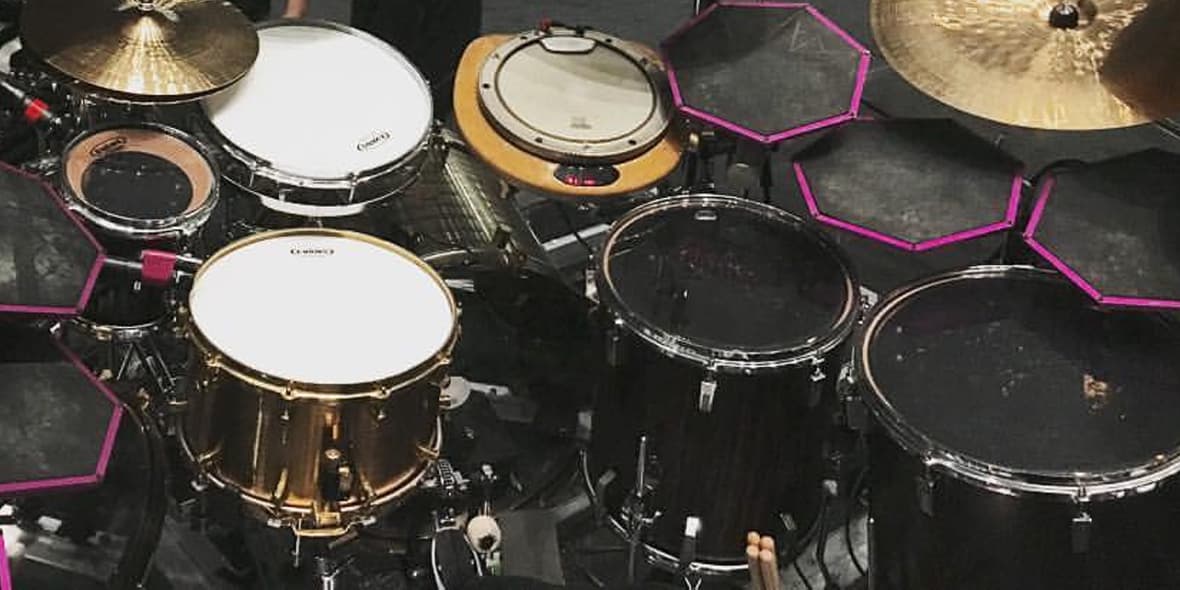Introduction
You might think that hybrid drums belong in the studios of EDM producers. But lately, more and more live drummers are using samples and triggers within urban, pop and even rock music to dramatic effect.
Put simply, hybrid drumming is the combination of employing traditional acoustic kits and modern electronic percussion. Whether that be the inclusion of a single trigger, a percussion pad or a more deeply integrated setup, it can change the scope of what’s possible for a drummer.

Why Hybrid and why now?
Recording and production techniques have come a long way in the last 50 years. As a result, producers are able to create and use any sounds they want. From synths to percussion, the sonic palette they have at their disposal is endless. As a live drummer, you may be faced with the challenge of recreating these sounds and effects on-the-fly. This is where a hybrid kit comes in.
Hybrid Setups
Welcome to the world of hybrid drums. Whilst you may be intrigued about the possibilities of a dual acoustic/electronic kit, you don't neccesarily have to dive right in with a massive, complicated setup. There's also opportunities to dip your toes, so to speak, where you can get a few additions for your kit without going crazy.
Let's take a look at a few ways you could incorporate electronic elements into your existing kit...
Just Dabbling
By simply adding a sample triggering pad to your setup, you can access a whole range of new sonic possibilities with minimal fuss. The Roland SPD One Percussion, Kick and Electro units each come with 22 built-in sounds and 12 sound banks, where the user can assign their own samples. This means that you can add a secondary snare sound, a tambourine or something a little more exotic.
Particularly useful are drum machine samples, which cannot be recreated by an acoustic instrument. Having access to sounds such as the classic 808 drum machine, or being able to utilise reverse cymbal sounds and alternate snare drums when playing electronic music, will add real authenticity to your sound.
If you’re playing at home, you will need an amp or PA system to connect the SPD One to. In a live environment, you can hook straight in to the house PA and let the sound engineer do their thing!
Taking things to the next level
The SPD One standalone triggers are great for adding in individual elements or custom samples. But if you want to step it up a notch and integrate multiple effects into your kit, a multi-trigger sample pad is the way to go.
They contain the same technology as the SPD One, but with multiple triggers that can be assigned as you choose. So now, you can add in that snare sound you want, some Latin percussion or maybe even a synth sample. Carry one box of tricks to gigs instead of your bongos, djembes and tambourines!
As a session player, if you’re looking to get involved with pop, urban or EDM – then this is definitely a great starting point. If you’re looking at taking things a little further, you could look at investing in an electronic drum kit.
Taking it to the max!
You will need:
- A laptop
- Percussion Pad (like the ones we mentioned above), or...
- Electronic drum module (like a Roland TD-50, for example) with one or more triggers.
Now, we can take this all even further. By using the MIDI I/O on the percussion pad or drum module, we can take advantage of advanced software, editing capabilities and enormous sample libraries. MIDI information generated by the acoustic triggers and drum module is sent to software such as Ableton Live, Logic Pro or Cubase. From here, you can use drum samples from BFD or Toontrack, as well as non-percussion or custom-built samples to create unique effects.
The triggers themselves could take the form of full-sized heads like the Roland PDX8 Mesh Head or the Roland RT30H Acoustic Drum Trigger. The latter actually allows you to clip the trigger on to your existing drum, and trigger a sample at the same time. This gives you plenty of options when it comes to integrating this technology into your current setup.
You could also use the triggers to launch various loops and samples, and arrange them into compositions on the fly. The sounds you use could be fragments of existing tracks, and your goal could be to create remixes, or loop the tracks and jam with them. By using loops and extended samples, you can start to accompany yourself and dabble with melodies as well as percussion.
What does this all mean for you?
The idea of the drum kit was initially conceived as a way for one musician to simultaneously play a whole range of percussion instruments. Hybrid drumming is the next logical step. It allows you to become more involved with the different aspects of music, and is an effective way to increase the role you can play within a band – being able to deal with the extra workload will make you invaluable as a musician.
A hybrid kit can really be taken to extremes, and using electronic percussion in such a way touches on “one man band” territory. Although these are not simple pick-up-and-play concepts, time spent with these ideas will really push the possible uses of acoustic/electronic percussion setups, and afford you an enormous amount of freedom in the way you can make music.


